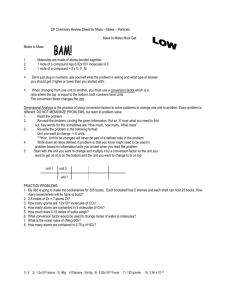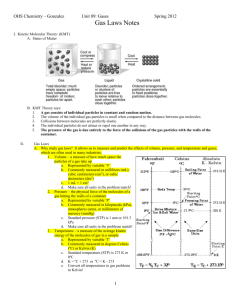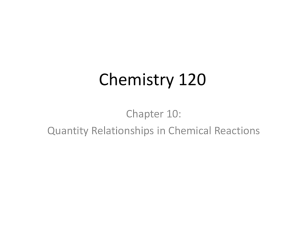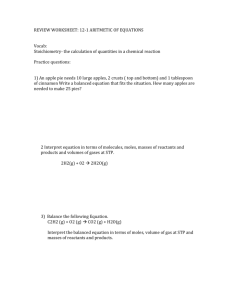1.3 a) Stoichiometry
advertisement
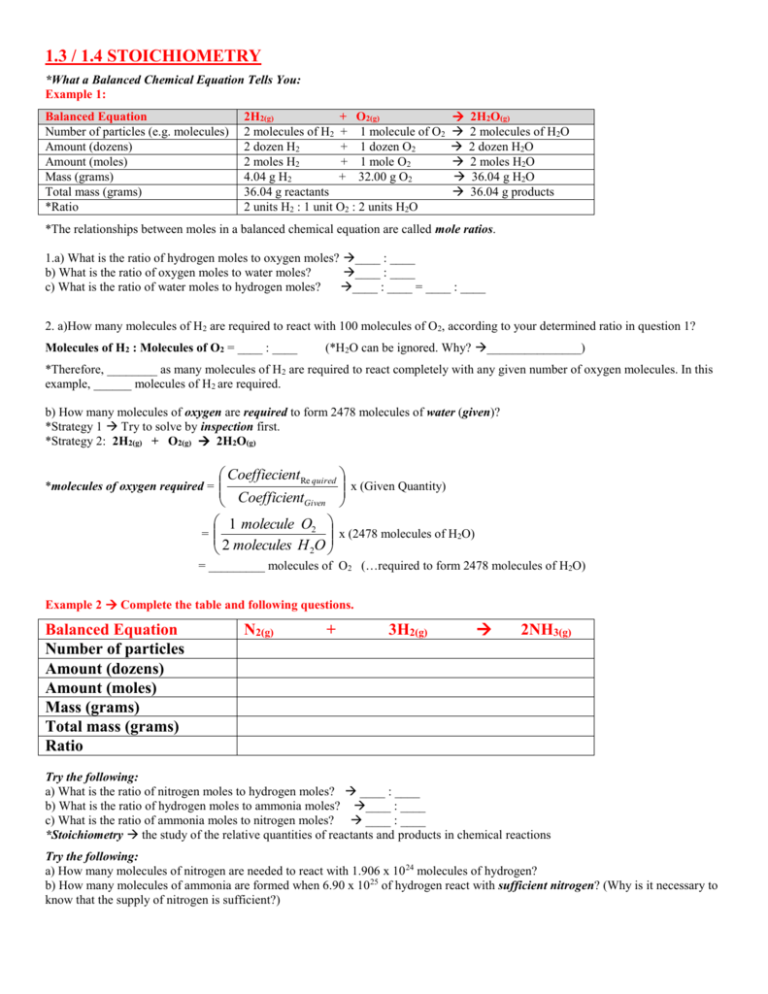
1.3 / 1.4 STOICHIOMETRY *What a Balanced Chemical Equation Tells You: Example 1: Balanced Equation Number of particles (e.g. molecules) Amount (dozens) Amount (moles) Mass (grams) Total mass (grams) *Ratio 2H2(g) + O2(g) 2 molecules of H2 + 1 molecule of O2 2 dozen H2 + 1 dozen O2 2 moles H2 + 1 mole O2 4.04 g H2 + 32.00 g O2 36.04 g reactants 2 units H2 : 1 unit O2 : 2 units H2O 2H2O(g) 2 molecules of H2O 2 dozen H2O 2 moles H2O 36.04 g H2O 36.04 g products *The relationships between moles in a balanced chemical equation are called mole ratios. 1.a) What is the ratio of hydrogen moles to oxygen moles? ____ : ____ b) What is the ratio of oxygen moles to water moles? ____ : ____ c) What is the ratio of water moles to hydrogen moles? ____ : ____ = ____ : ____ 2. a)How many molecules of H2 are required to react with 100 molecules of O2, according to your determined ratio in question 1? Molecules of H2 : Molecules of O2 = ____ : ____ (*H2O can be ignored. Why? _______________) *Therefore, ________ as many molecules of H2 are required to react completely with any given number of oxygen molecules. In this example, ______ molecules of H2 are required. b) How many molecules of oxygen are required to form 2478 molecules of water (given)? *Strategy 1 Try to solve by inspection first. *Strategy 2: 2H2(g) + O2(g) 2H2O(g) CoeffiecientRe quired x (Given Quantity) CoefficientGiven 1 molecule O2 x (2478 molecules of H2O) = 2 molecules H 2O *molecules of oxygen required = = _________ molecules of O2 (…required to form 2478 molecules of H2O) Example 2 Complete the table and following questions. Balanced Equation Number of particles Amount (dozens) Amount (moles) Mass (grams) Total mass (grams) Ratio N2(g) + 3H2(g) 2NH3(g) Try the following: a) What is the ratio of nitrogen moles to hydrogen moles? ____ : ____ b) What is the ratio of hydrogen moles to ammonia moles? ____ : ____ c) What is the ratio of ammonia moles to nitrogen moles? ____ : ____ *Stoichiometry the study of the relative quantities of reactants and products in chemical reactions Try the following: a) How many molecules of nitrogen are needed to react with 1.906 x 10 24 molecules of hydrogen? b) How many molecules of ammonia are formed when 6.90 x 1025 of hydrogen react with sufficient nitrogen? (Why is it necessary to know that the supply of nitrogen is sufficient?) *Mass-Mass Problem c) What mass of hydrogen is required to react completely with 16.4 g of nitrogen? Steps: 1) Write a balanced chemical equation if not provided. 2) Convert given mass to moles. (i.e. Convert 16.4 g of nitrogen into moles. *Formula ) 3) Determine the number of moles of hydrogen (i.e. the unknown) required to react completely with the number of moles of nitrogen calculated in step 1 using the appropriate mole ratio. 4) Convert your answer from step 3 into a mass in grams. (*Formula ) *Stoichiometry – Practice Quiz (Try after completing text work.) 1. Ammonia (NH3) can be produced by the reaction of Li3N and water. A by-product (i.e. an additional product) of the reaction is lithium hydroxide. a) Write a balance chemical equation for this reaction. b) Write the ratio of Li3N molecules: H2O molecules: LiOH molecules: NH3 molecules. c) How many molecules of water are required to react with 4728 molecules of Li 3N? d) How many moles of lithium hydroxide will be produced if 1.27 moles of Li 3N are reacted with excess water? e) How much Li3N is required to react with excess water to produce 35.4 g of NH3? 2. Mass/Mass Problems a) Calculate the mass of iron(III) oxide (rust) produced by the reaction of 500 g of iron with oxygen from the air. b) What mass of precipitate should form if 2.00 g of silver nitrate in solution is reacted with excess sodium sulfide solution? c) Determine the mass of water vapour formed when 1.00 g of butane, C 4H10, is burned in a lighter. What type of reaction is this? d) Application: Space Mission A spacecraft is a closed system. Carbon dioxide is produced when astronauts breathe. To maintain a low level of carbon dioxide, air in the cabin is passed continuously through canisters of lithium hydroxide granules. The lithium hydroxide reacts with carbon dioxide to produce solid lithium carbonate and gaseous water. a) Write the balanced chemical reaction. Engineers must calculate the amount of lithium hydroxide needed to ensure that the carbon dioxide levels are safe. In space, every kilogram counts. Therefore, it is important that the spacecraft not carry much more than the minimum amount. Problem An astronaut produces an average of 1.0 kg of carbon dioxide each day. What mass of lithium hydroxide should engineers put on board the spacecraft if there are 3 astronauts embarking on a ten day mission? *LIMITING AND EXCESS REACTANTS “Warm-Up” Activity The Limiting Item Imagine that you are in the business of producing cars. A simplified “equation” for making a car is: 1 car body + 4 wheels + 2 wiper blades 1 car 1. Assume that you have 35 car bodies, 120 wheels, and 150 wiper blades in your factory. How many complete cars can you make? 2. (a) Which item “limits” the number of complete cars that you can make? Stated another way, which item will “run out” first? (b) Which items are present in excess amounts? (c) How much of each “excess” item remains after the “reaction”? 3. Does the amount that an item is in excess affect the quantity of the product that is made? Explain. 4. There are fewer car bodies than wheels and wiper blades. Explain why car bodies are not the limiting item, in spite of being present in the smallest amount. Limiting and Excess Reactants Predict, Observe & Explain (POE) Introduction: You will predict and observe a limiting reactant. You will observe the single displacement reaction of aluminum with aqueous copper(II) chloride: 2Al(s) + 3CuCl2(aq) 3Cu(s) + 2AlCl3(aq) *Note that copper(II) chloride, CuCl2, is light blue in aqueous solution. This is due to the Cu2+(aq) ion. Aluminum chloride, AlCl3(aq), is colourless in aqueous solution. *Focus Question How can observations tell you which is the limiting reactant in the reaction of aluminum with aqueous copper(II) chloride? *A beaker contains a 0.25 g piece of aluminum foil and 0.51 g of copper(II) chloride. 1. Predict which one of these 2. Explain your prediction. (i.e. reactants is the limiting reactant. Before you observe Why did you make the prediction you did?) 3. Observe a) Record the colour of the solution and the metal that is present at the beginning of the reaction. b) Record any colour changes as the reaction proceeds. 4. Explain *Was your prediction right? (i.e. How does your prediction compare with your observations?) *If your prediction of the limiting reactant was incorrect, explain why. 5. Summarize what you learned from this POE. 6. Analysis Support your observations of the limiting reactant using stoichiometric calculations. 7. Making Connections Magnesium and hydrochloric acid react according to the following skeleton equation: Mg(s) + HCl(aq) MgCl2(aq) + H2(g) a) Balance the skeleton equation. b) Examine the equation carefully. What evidence would you have that a reaction was taking place between the hydrochloric acid and the magnesium? c) You have a piece of magnesium of unknown mass, and a beaker of water in which is dissolved an unknown amount of hydrogen chloride. How could you determine the limiting reactant by observation? PERCENTAGE YIELD *Theoretical Yield the amount of product that is predicted by stoichiometry *Actual Yield the amount of product obtained in an experiment or industrial process *Percentage yield = Actual yield Theoretical yield x 100% *Why Actual Yield and Theoretical Yield are Often Different: 1. Poor Experimental Technique and/or Design: e.g., collection of product via filtration (some product may be left in solution or filter paper) 2. Presence of Competing Reactions: Competing reaction = a side reaction that occurs at the same time as a principal reaction Example: 2P(s) + 3Cl2(g) 2PCl3(l) *principal rxn PCl3(l) + Cl2(g) PCl5(s) *competing rxn **Not all of the phosphorus is converted into PCl3(l). 3. Impure Reactants: The theoretical yield is calculated based on the assumption that the reactants are pure. *Why is percentage yield important? Extremely important in: industrial chemistry; and, the pharmaceutical industry. *A chemical engineer working in either of these industries may use thousands of kilograms of reactants. A difference in 1% in the yield of a reaction can translate into thousands of dollars!
